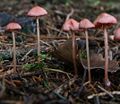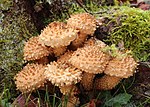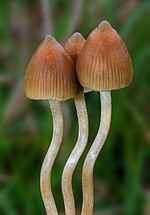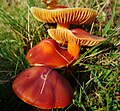Paul Kummer (22 August 1834 – 6 December 1912) was a minister, teacher, and scientist in Zerbst, Germany, known chiefly for his contribution to mycological...
4 KB (386 words) - 23:06, 11 June 2024
Kummer is a German surname. Notable people with the surname include: Bernhard Kummer (1897–1962), German Germanist Clare Kummer (1873—1958), American...
2 KB (291 words) - 07:11, 28 April 2024
Jay Sebring (redirect from Thomas Kummer)
Thomas John Kummer (October 10, 1933 – August 9, 1969), known professionally as Jay Sebring, was an American celebrity hair stylist, and the founder of...
15 KB (1,617 words) - 23:26, 9 November 2024
in 1794, it was assigned its current name in 1871 by German scientist Paul Kummer. Microscopic characteristics The spores are amyloid and have dimensions...
2 KB (121 words) - 21:16, 16 May 2024
Pierre Bulliard in 1793, it was transferred to the genus Psilocybe by Paul Kummer in 1871. In the first decade of the 2000s, several molecular studies...
5 KB (455 words) - 17:34, 30 May 2024
Georg Karl Batsch. It was later placed in the genus Clitocybe in 1871 by Paul Kummer as Clitocybe nebularis. After much consideration by many mycologists...
6 KB (574 words) - 17:41, 12 July 2024
Hendrik Persoon, it was assigned its current name in 1871 by German Paul Kummer. Mycena pura is known to bioaccumulate the element boron. Mycena pura...
5 KB (559 words) - 00:45, 19 April 2024
Hygrophorus by Elias Magnus Fries in 1838, and finally Hygrocybe by Paul Kummer in 1871. The specific epithet coccinea is Latin for "scarlet". A small...
4 KB (449 words) - 09:06, 12 March 2024
fungorum" in 1801. In 1871, it was renamed to Clitocybe phyllophila by Paul Kummer in his book "Der Führer in die Pilzkunde" (The Guide to Fungi). However...
11 KB (1,134 words) - 23:04, 6 November 2024
German polymath Jacob Christian Schäffer, who named it Agaricus conicus. Paul Kummer transferred it to the genus Hygrocybe in 1871. Recent molecular research...
7 KB (598 words) - 22:51, 10 November 2024
first described in 1796 by Christiaan Hendrik Persoon and renamed by Paul Kummer in 1871. It is inedible. Like other Crepidotus, it has brown spore powder...
3 KB (214 words) - 07:29, 10 May 2024
mushrooms within a very broad Agaricus as Agaricus ostreatus (Jacq. 1774). Paul Kummer defined the genus Pleurotus in 1871; since then, the genus has been narrowed...
20 KB (1,719 words) - 13:15, 28 October 2024
1800. In 1871 in his "Führer in die Pilzkunde" ("Guide to mycology"), Paul Kummer introduced Pleurotus as a genus and defined three similar ringed species:...
11 KB (902 words) - 02:33, 19 April 2024
later years there were defined the combinations Clitocybe flaccida (by Paul Kummer, 1871), Clitocybe inversa (by Lucien Quélet, 1872), and Lepista flaccida...
13 KB (1,327 words) - 01:15, 18 May 2024
recorded. In 1871 in his "Führer in die Pilzkunde" ("Guide to Mycology"), Paul Kummer introduced Pleurotus as a genus, but the allocation of P. cornucopiae...
10 KB (1,082 words) - 14:18, 1 June 2024
rare in the region, though had found some in Ovenden. German mycologist Paul Kummer placed it in the genus Tricholoma in 1871, the same year that English...
16 KB (1,595 words) - 06:51, 29 July 2024
Elias Fries in 1818, and later transferred to the genus Tricholoma by Paul Kummer in 1871. It is found in the deciduous and coniferous forests of Europe...
4 KB (281 words) - 11:07, 17 February 2024
Mycologicum. It was transferred to the genus Pholiota by the German Paul Kummer. It is the type species of the genus Pholiota. The specific epithet squarrosa...
16 KB (1,611 words) - 22:52, 28 August 2024
Agaricus semilanceatus in his 1838 work Epicrisis Systematis Mycologici. Paul Kummer transferred it to Psilocybe in 1871 when he raised many of Fries's sub-groupings...
55 KB (5,902 words) - 23:24, 10 November 2024
Hendrik Persoon in 1794. It was given its current binomial name by German Paul Kummer in 1871. It is commonly known as the grey knight from its discoloured...
9 KB (860 words) - 04:40, 10 January 2024
by German naturalist August Batsch in 1786 as a species of Agaricus. Paul Kummer transferred it to the genus Pholiota in 1871. P. adiposa produces a mushroom...
12 KB (1,136 words) - 00:04, 25 October 2024
Vahl in 1790; it was transferred to the genus Armillaria in 1871 by Paul Kummer. Numerous subtaxa have been described: Armillaria mellea once included...
31 KB (2,939 words) - 12:00, 28 October 2024
Pierre Bulliard called it Agaricus orcella in 1793. German botanist Paul Kummer erected the genus Clitopilus and gave the miller its current name in...
9 KB (918 words) - 12:04, 28 October 2024
Lucien Quélet in 1886. It was given its current binomial name by German Paul Kummer in 1871. The British Mycological Society has listed "white knight" as...
8 KB (715 words) - 04:40, 10 January 2024
Then in 1871 in his guide to mycology ("Der Führer in die Pilzkunde"), Paul Kummer allocated the species to the genus Clitocybe, which previously (according...
9 KB (831 words) - 01:26, 15 May 2024
puniceus, the Latin "puniceus" meaning "blood red". German mycologist Paul Kummer transferred it to the genus Hygrocybe in 1871. Recent molecular research...
8 KB (643 words) - 08:50, 27 August 2024
Eccilia had umbilicate caps and adnate gills. In 1871 German mycologist Paul Kummer raised these tribes and subtribes to genera. Additional genera were added...
20 KB (1,759 words) - 06:47, 2 November 2024
by the same author in 1838 as Hygrophorus miniatus. German mycologist Paul Kummer then assigned it to the genus Hygrocybe in 1871. The specific epithet...
6 KB (616 words) - 14:43, 10 January 2024
mushroom has been known. It was placed in the genus Tricholoma by German Paul Kummer in his 1871 work Der Führer in die Pilzkunde. The generic name derives...
10 KB (1,115 words) - 06:39, 5 November 2024
Claude Gillet transferred it in 1878 to the genus Volvaria erected by Paul Kummer just a few years earlier in 1871. The name Volvaria was already taken...
22 KB (2,119 words) - 19:46, 14 October 2024




























